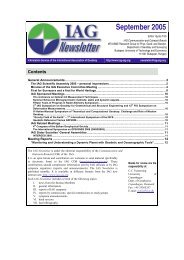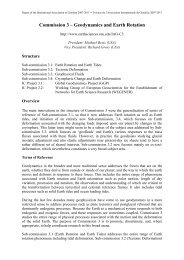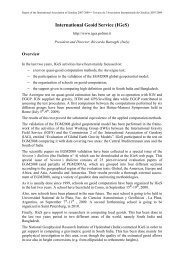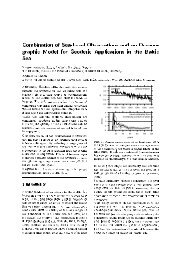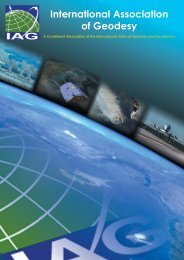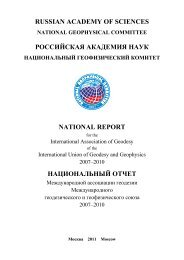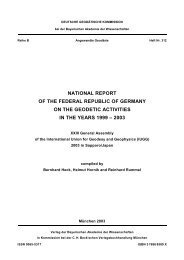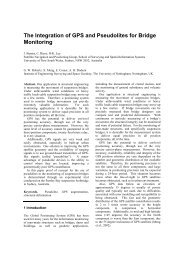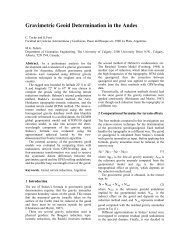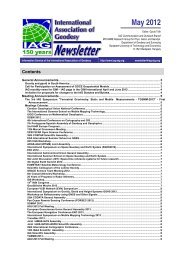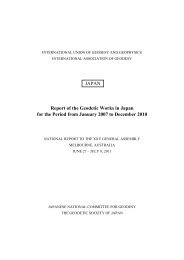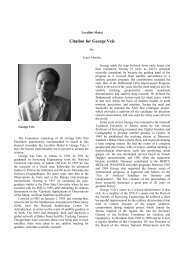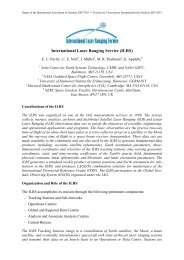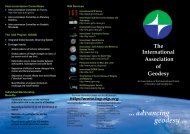International Earth Rotation and Reference Systems Service (IERS)
International Earth Rotation and Reference Systems Service (IERS)
International Earth Rotation and Reference Systems Service (IERS)
You also want an ePaper? Increase the reach of your titles
YUMPU automatically turns print PDFs into web optimized ePapers that Google loves.
<strong>International</strong> <strong>Earth</strong> <strong>Rotation</strong> <strong>and</strong> <strong>Reference</strong> <strong>Systems</strong> <strong>Service</strong> (<strong>IERS</strong>)web: www.iers.orgChair of the Directing Board: Jan Vondrák (Czech Rep.)Director of the Central Bureau: Bernd Richter (Germany)DevelopmentThe <strong>IERS</strong> is a service under the Federation of Astronomical<strong>and</strong> Geophysical Data Analysis <strong>Service</strong>s (FAGS),established in 1987 by the <strong>International</strong> AstronomicalUnion <strong>and</strong> the <strong>International</strong> Union of Geodesy <strong>and</strong>Geophysics. Since 2001, the <strong>IERS</strong> works in a neworganizational structure; in 2003, the new name of the<strong>Service</strong>, without changing its abbreviation, was adopted.ObjectivesThe primary objectives of the <strong>IERS</strong> are to serve theastronomical, geodetic <strong>and</strong> geophysical communities byproviding the following:- The <strong>International</strong> Celestial <strong>Reference</strong> System (ICRS)<strong>and</strong> its realization, the <strong>International</strong> Celestial <strong>Reference</strong>Frame (ICRF)- The <strong>International</strong> Terrestrial <strong>Reference</strong> System (ITRS)<strong>and</strong> its realization, the <strong>International</strong> Terrestrial<strong>Reference</strong> Frame (ITRF)- <strong>Earth</strong> orientation parameters required to study earthorientation variations <strong>and</strong> to transform between theICRF <strong>and</strong> the ITRF- Geophysical data to interpret time/space variations inthe ICRF, ITRF or earth orientation parameters, <strong>and</strong>model such variations- St<strong>and</strong>ards, constants <strong>and</strong> models (i.e., conventions)encouraging international adherenceProducts<strong>IERS</strong> collects, archives <strong>and</strong> distributes products to satisfythe objectives of a wide range of applications, research <strong>and</strong>experimentation. These products include the following:- <strong>International</strong> Celestial <strong>Reference</strong> Frame- <strong>International</strong> Terrestrial <strong>Reference</strong> Frame- Monthly earth orientation data- Daily rapid service estimates of near real-time earthorientation data <strong>and</strong> their predictions- Announcements of the differences betweenastronomical <strong>and</strong> civil time for time distribution byradio stations- Leap second announcements- Products related to global geophysical fluids such asmass <strong>and</strong> angular momentum distribution- Annual report <strong>and</strong> technical notes on conventions <strong>and</strong>other topics- Long-term earth orientation informationThe accuracies of these products are sufficient to supportcurrent scientific <strong>and</strong> technical objectives including thefollowing:- Fundamental astronomical <strong>and</strong> geodetic referencesystems- Monitoring <strong>and</strong> modeling earth rotation/orientation- Monitoring <strong>and</strong> modeling deformations of the solidearth- Monitoring mass variations in the geophysical fluids,including the atmosphere <strong>and</strong> the hydrosphere- Artificial satellite orbit determination- Geophysical <strong>and</strong> atmospheric research, studies ofdynamical interactions between geophysical fluids <strong>and</strong>the solid earth- Space navigation.StructureThe <strong>IERS</strong> accomplishes its mission through the followingcomponents:- Technique Centers- Product Centers- Combination Center(s)- Analysis Coordinator- Central Bureau- Directing Board- Working Groups.
Some of these components (e.g., Technique Centers) maybe autonomous operations, structurally independent from<strong>IERS</strong>, but which cooperate with the <strong>IERS</strong>. A participatingorganization may also function as one or several of thesecomponents (except as a Directing Board).Directing BoardClaude Boucher, Carine Bruyninx, Benjamin F. Chao,Daniel Gambis, Gernd Gendt, Chopo Ma, Dennis D.McCarthy, Ron Noomen, Axel Nothnagel, David Pugh,Bernd Richter (Central Bureau), Markus Rothacher, BobSchutz, Peter Shelus, Jean Souchay, Jan Vondrák (Chair),Pascal Willis, William Wooden, Clark R. Wilson, <strong>and</strong>Sheng Yuan Zhu.



